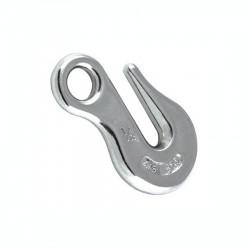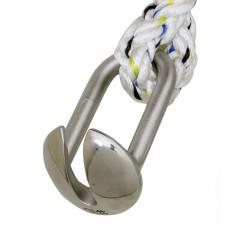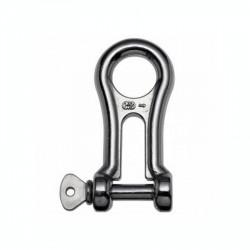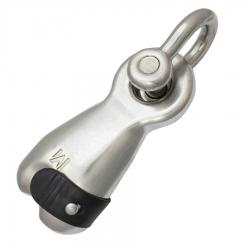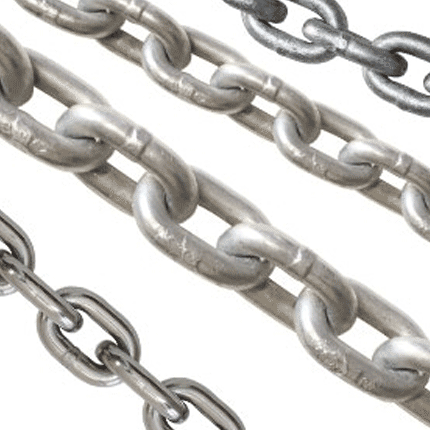A guide to taking the shock load off your windlass and chain
Electric windlasses are now commonly fitted on cruising yachts from the outset, and they are also proving to be a popular upgrade for owners of older yachts.
Anchor rodes comprising only chain are becoming correspondingly more prevalent. There are still plenty of good reasons to extend your chain with a stretchy warp. Chain and warp combinations featuring LIROS Anchorplait White Nylon spliced to the anchor chain have been a speciality at Jimmy Green Marine for decades, but this is the subject of another article.
If your anchor rode is all chain or all chain with some extra warp that’s rarely used, there are some critical points you may want to consider.
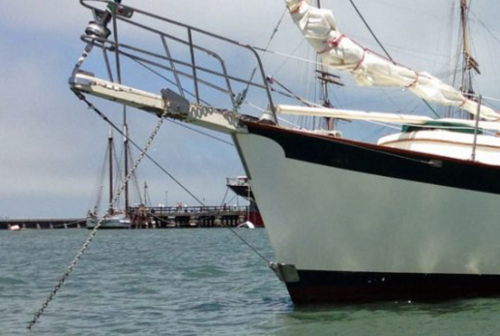
Don’t rely on the windlass as a brake. It isn’t designed to withstand the snatch loads of an anchor rode. Many options can be used to take the load off the chain, e.g., a specifically designed chain stopper, a substantial restraining pin through a chain link or simply wrapping the chain around any convenient cleat or bollard.
Scope and Catenary
Laying plenty of chain has a calming effect on a yacht’s anchoring behaviour in benign weather. It helps to limit the arc created during a swing in the prevailing conditions and stop the yacht from sailing around its anchor. The amount of chain laid along the seabed before rising to the yacht determines the precautionary allowance of slack that needs to be straightened before it is brought up short or taut. The dampening effect of the catenary is dependent mainly on the length of the anchor chain, but the weight is a helpful factor.
However, when conditions deteriorate, the weight of the catenary has little effect, and the length of the chain in proportion to the depth of water in the anchorage is the most crucial factor. This proportion is known as scope and is measured as a ratio e.g. 6:1 would relate to 60 metres of chain deployed in 10 metres depth. There is no scientific/mathematical rule to arrive at the correct ratio for your yacht because there are important variables, not least the depth of the anchorage. However, it is generally considered that 5:1 is a good starting point rising up to 10:1 for world cruising. There are research articles that state 8:1 to be the optimum scope in adverse conditions.

Adverse conditions involving excessive wind, tide, waves or swell may lead to the yacht being frequently brought up short. This causes a shock load on the anchor rode which has a detrimental effect on the chain and connectors, the strong point and eventually the holding power of the anchor, not to mention the comfort of the crew.
Anchor snubbing is an excellent method of dampening the shock load for anchor rodes that are all chain. The main principle of snubbing is to deploy a stretchy line from a strong point on the foredeck to a link on the chain beyond the bow. The chain can then be slackened. This takes the strain off the windlass and allows the snubbing line to take the shock load.
Deciding on how comprehensive and bespoke a solution is required comes down to your anticipated cruising intentions. Consideration should be given to likely anchoring conditions, time spent at anchor, with or without crew on board and a worst-case scenario evaluation.
Chain Hooks or Chain Grabs
Plenty of Chain Hook and Grab options are available for attaching to the anchor chain. These are divided between captive and non-captive versions.
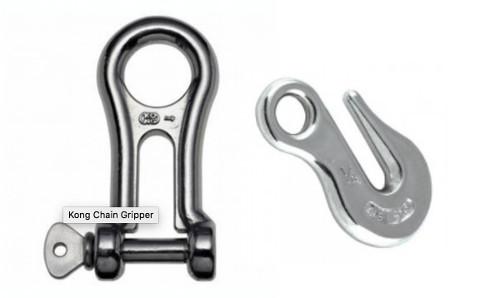
Non-captive chain hooks remain attached under load but may detach when the snubbing line is slack. During deployment, the bitter end of the snubbing line must be made off to a strong point first. The hook can then be attached to the chain and held in place by maintaining tension in the snubbing line whilst paying out the chain. Tension must be maintained until the strong point is taking the load. This will prevent the hook from detaching during deployment. It is worth noting that it is virtually impossible for a non-captive hook to detach once correctly deployed and under load. The Standard Chain Hook and Ultra Chain Grab are both non-captive chain hooks. The Ultra chain grab is also designed to be attached to a vertical chain whilst suspended from the snubbing line. The Standard Chain hook needs to be installed by hand directly to the chain.
Captive chain hooks are more secure but correspondingly more awkward to fit/remove when leaning over the bow, especially in a seaway. During deployment, these hooks can be attached prior to securing the snubbing line without fear of the hook detaching. This means everything can be secured and checked prior to paying out the chain. This is especially useful with V-bridles that are commonly longer than strops. The Mantus Chain Hook, Kong Gripper and Wichard Chain Hook are all captive chain hooks.
Sizing and Layout
Whichever hook you decide to use, the snubbing line diameter is typically one size down from your Anchor Warp Size for coastal hopping. The lighter diameter line will give more stretch under load and a more comfortable anchoring experience. For those living at anchor, ensuring your snubber is as strong as the rest of the anchoring system will bring greater peace of mind, especially when the breeze picks up during the night. The trade-off for stronger snubbing lines is that they stretch less under a similar load to lighter lines and offer less cushioning. Increasing the length of the snubbing line or introducing rubber snubbers will compensate for the loss in rope stretch. Having decided on the diameter of your snubber, there are two options for the configuration of an anchor chain snubber.
Chain Snubbing Strops are single lines fastened from the chain to a deck strong point. This is the simplest solution available. A strop is commonly led over the bow roller but can also be passed through a gunwale-mounted fairlead for convenience during a lunch stop. If used as the primary snubber, care should be taken to make sure the line stays clear of abrasive surfaces. This may include the anchor chain, bow roller fittings and other deck fittings up near the bow. The snubbing line needs to extend beyond the bow by 1-5m depending on the size of the boat. Liros 3-strand Nylon is ideal for such applications.
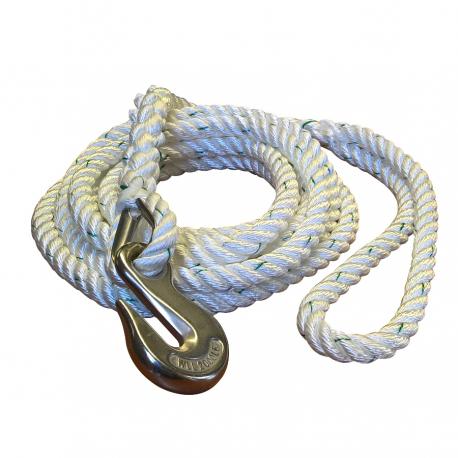
Chain Snubbing V-Bridles are the most popular solution for the discerning cruiser looking for a more substantial set-up. V-Bridles spread the load between two legs. Both legs need to be able to take the full load because the boat will not always remain straight on to the conditions during adverse weather. Therefore, a bridle should be the same diameter as an equivalent strop. The main drawback is that when both sides of the bridle are loaded simultaneously, the load for each side is halved, and therefore, the spring is significantly reduced. This can be mitigated by increasing the overall length of the V-Bridle. The extra length will help increase the spring in the line. V-bridles typically extend 3-10 metres beyond the bow depending on the size of the boat. The bridle is created using Anchorplait or Octoplait Nylon. The 8-plait construction is ideal for centre-eye splicing. A simple Brummel locking tuck in the middle of the snubbing line provides two tails which can be led on either side of the bow to strong points. This means the snubber will remain clear of all abrasion points at the bow while maintaining a central pull on the chain.

Main Menu
Main Menu
Back
Main Menu
Back
Main Menu
Back
Back
Main Menu
Back
Main Menu
Back
Back
Main Menu
Back
Main Menu
Main Menu
Back
Main Menu
Back
Back
Back
Back
Back
Back
Back
Back


















